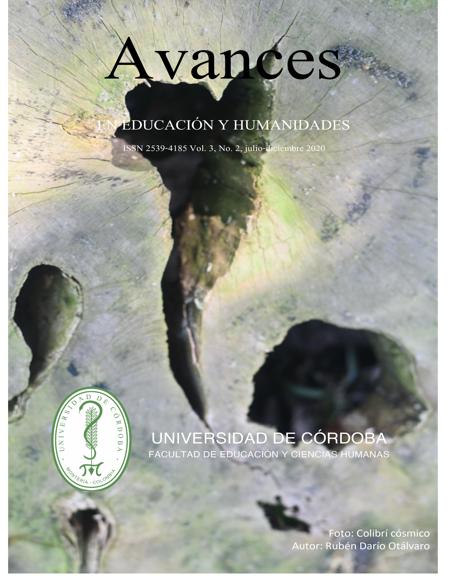Learning approach based on tasks for the development of the desire to communicate in the English class.
Enfoque de aprendizaje basado en tareas para el desarrollo del deseo de comunicación en la clase de inglés

This work is licensed under a Creative Commons Attribution-NonCommercial-NoDerivatives 4.0 International License.
Show authors biography
The purpose of this study was to determine the influence of the task-based learning approach on the development of the
desire to communicate in the English class in seventh grade students with little desire to communicate in the second
language (L2), belonging to the educational institution San Luis Campo Alegre. An investigative design of analysis of
variance of repeated series was followed, in which repeated measurements of the dependent variable were made desire to
communicate of the students, at the beginning, during and at the end of the intervention. For the measurement of this
variable, the WTC scale McCroskey & Richmond (2013) was used. For the analysis and tabulation of the information, the
statistical program SPSS v 21 was used, using the Wilcoxon test and anova model in repeated measures. The analysis of
the data could confirm that the application of the task-based approach positively influenced the improvement of students’
communication desire, with statistically significant results. This suggests that the task-based approach, in addition to
promoting the improvement of competencies in L2, contributes to the development of motivational aspects such as the
desire to communicate in the new language. Based on these results, task-based learning is proposed as an alternative to
transform classroom practices in the teaching of English in the context of public schools.
Article visits 343 | PDF visits
Downloads
- Cao, Y., & Philp, J. (2006). Interactional context and willingness to communicate: a comparison of behavior in whole class, group and dyadic interaction.System, 34(4), 480e493.
- Colombia. Ministerio de Educación Nacional [MEN]. (2016). Esquema curricular sugerido grados de 6° a 11°.English for diversity and equity.
- Chan, B., & McCroskey, J. (1987). The WTC scale as a predictor of classroom participation. Com-
- munication Reports, 4, 47-50.
- Dawood, A, M. (2014). Willingness to Communicate in English: A Case Study of EFL Students at King Khalid University.English Language Teaching, (7), No. 7.1-9.Doi:10.5539/elt.v7n7p17
- Dornyei, z. (2001). The motivational basis of language learning tasks. 1-12 .University of Notting- ham.
- Eddy, M. (2015).Motivation for participation and non-participation in group tasks: a dynamic system model of task-situated willingness to communicate. Elsevier,(50), 43-55. Doi.org/10.1016/j. system.2015.03
- Farahanni, A. (2007).A Study of Task-based Approach: The Effects of Task- based Techniques, Gender, and Different Levels of Language Proficiency on Speaking Development.Pazhuhesh-e Zabanha-ye Khareji, 49, 23-41.
- Freiermuth, M. &Jarrell, D. (2006). Willingness to communicate: can online chat help. International Journal off applied linguistics, (16). 189-21 Doi: 10.1111/j.1473-4192.2006.00113.x
- Freiermuth, M. R., & Huang, H. C. (2012). Bringing Japan and Taiwan closer electronically: A look at an intercultural online synchronic chat task and its effect on motivation. Languaje Teaching Reserach, 16(1). 61-88. Doi: 10.1177/13621688114223341
- Good, T. y Brophy, J.E. (1990). Psicología educacional. México: Interamericana.
- Harmer, J. (2007). “How to teach English”, England: new edition. Pearson Education limited Edin- burgh Gate Harlow Essex CM20 2JE England and Associated companies.
- Hashimoto, Y. (2002).Motivation and willingness to communicate as predictors of reported L2 use: the Japanese ESL context. Second Language Studies, VOL 20(2), 29-70.
- Herazo, J. (2010). Authentic Oral Interaction in the EFL Class: What It Means, What It Does not.
- Revistas. unal.edu.co, 12(1), 47-61 Huang, J. &Andrews, S. (2010) Situated development and use of language learner strategies: voices from
- EFL students, The Language Learning Journal,38:1, 19-35.DOI: 1080/09571730902717430 Jin, L.& Cortazzi, M. (1998). The culture the learner brings: A bridge or a barrier?, In Language
- learning in intercultural perspective: Approaches through drama and ethnography (pp. 98- 118). Cambridge: Cambridge University Press. viii Op cit
- Kuehl, R. (2001). Diseño de experimentos.México. D.F. (2ª ed.).Thomson Learning.
- Maquilón, J. y Hernández, P. (2011). Influencia de la motivación en el rendimiento académico de los estudiantes de formación profesional. REIFOP, 14 (1), 81-100.
- McCroskey, J. C., & Richmond, V. P. (1991). Willingness to communicate: a cognitive view. In M.
- Booth-Butterfield (Ed.), Communication, cognition, and anxiety (pp. 19e37). Newbury Park, CA: Sage.
- McCroskey, J. C., & Richmond, V. P. (2013). Willingness To Communicate (WTC). Measurement Instrument Database for the Social Science. Retrieved from www.midss.ie
- McCroskey, J. C., & Richmond, V. P. (1991). Willingness to communicate: a cognitive view. In M. Booth-Butterfield (Ed.), Communication, cognition, and anxiety (pp. 19e37). Newbury Park, CA: Sage.
- Mohammad, A. (2008).A Study of Reading Strategies Using Task-Based Strategy Assessment.Jour- nal of English Language Teaching and Learning Year 53 No. 217
- Pawlak, M, & Mystkowska, A (2015). Investigating the dynamic nature of L2 willingness to Commu-
- nicate.Elsevier,(50), 1-9. Doi.org/10.1016/j.system.2015.02.001
- Peng, J, (2006).Willingness to Communicate in an L2 and Integrative Motivation among College Students in an Intensive English Language Program in China.University of Sydney Papers in TESOL, (2), 33-59.
- Qunyang, M, (2011). Understanding Chinese learners’ willingness to communicate in a New Zealand ESL classroom: A multiple case study drawing on the theory of planned behavior. Elsevier,(41), 740-751. Doi.org/10.1016/j.system.2013.08.001
- Ruiz, B, C. (2013). Instrumentos y Técnicas de Investigación Educativa. DANAGA. Texas, USA.
- Samuda, V, (2007).Tasks, design, and the architecture of pedagogical spaces.TBLT Conference, 2nd
- International TBLT Conference, Hawai’i USA
- Sampson, R, J. (2015).Tracing motivational emergence in a classroom language learning project.
- Elsevier,(50), 1-20.Doi.org/10.1016/j.system.2015.03.001
- Tainio, S. (2009).Collaborative Game-play as a Site for Participation and Situated Learning of a Second Language.Scandinavian Journal of Educational Research,53, No. 2,167-183.Doi 10.1080/00313830902757584
- Van Lier, L. (1996). Interaction in the Language Curriculum: Awareness, Autonomy, and Authenticity Applied linguistics and language study. London, Inglaterra: Longman


